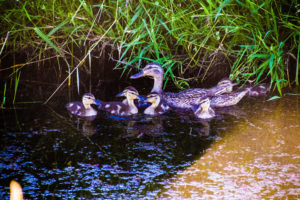We are into the summer doldrums. It’s been hot. The number of visitors to the River S has  dropped. Hot and dusty is not a favorite time to visit our refuge. Besides, there aren’t many animals to see some will say. Well, that isn’t necessarily so. (The hot part is; the lack of animals isn’t.) It just requires a lot more patience and some thought about why that might seem to be the case. June produced many baby animals running around. Sightings were abundant. The bird parents were busy bringing food to the nests or taking out their chicks to learn how to find food.
dropped. Hot and dusty is not a favorite time to visit our refuge. Besides, there aren’t many animals to see some will say. Well, that isn’t necessarily so. (The hot part is; the lack of animals isn’t.) It just requires a lot more patience and some thought about why that might seem to be the case. June produced many baby animals running around. Sightings were abundant. The bird parents were busy bringing food to the nests or taking out their chicks to learn how to find food.
Now that the parents have weaned the kids to find their own way, it is time for them to start working on their next stage in the annual cycle of life. Depending on the species, it is time for molting. It takes a lot of energy to do courtship, build nests, and feed young. But equally, it takes a lot of energy to grow new feathers. Therefore, these activities happen in sequence. The young have been eating like crazy, getting bigger and growing their first real feathers. The parents, once chick rearing duties are done, can now eat for themselves and use that energy to build new feathers for the coming migration. Molting can be a vulnerable time of year; flight feathers are weak or have been lost as they molt. Feathers do molt in sequence, so most birds aren’t totally unable to fly. But this causes many species to seek hiding places for the few weeks of feather repair. It keeps them out of harms way from predators looking for meals to feed their offspring. With the abundance of vegetation, deep brush is the place to be during molt.
As the young look more and more like their parents, to the novice observer, there can be a lot of confusion as to the species that are being observed. Sparrows and finches can be very challenging. In some cases, there are only hints of feather pattern to come. Best is to catch a group of sparrows on the ground and watch which ones are begging. A quick look at the  exhausted and bothered adult can help you identify the species of the growing chick. It is a good opportunity to study the new bird. Sometimes shape will help sort through the identification. While driving around recently, I could see a juvenile bird in the water at some distance. Lighting was bad, but the head shape was very apparent. We have a lot of Coot and Pied-billed Grebe chicks in the remaining ponds now. Clearly, just from the outlined shape of the head, this was a young Pied-billed Grebe. In good light, I might have seen the striping on the head and neck and the pinkish-orange on the bill; but that wasn’t the case for my distant bird.
exhausted and bothered adult can help you identify the species of the growing chick. It is a good opportunity to study the new bird. Sometimes shape will help sort through the identification. While driving around recently, I could see a juvenile bird in the water at some distance. Lighting was bad, but the head shape was very apparent. We have a lot of Coot and Pied-billed Grebe chicks in the remaining ponds now. Clearly, just from the outlined shape of the head, this was a young Pied-billed Grebe. In good light, I might have seen the striping on the head and neck and the pinkish-orange on the bill; but that wasn’t the case for my distant bird.
Fields have been mowed and bailed. As I watched this happening in July, the Turkey Vultures were coming in for a landing to pick up any tractor kill. They were all smiling; at least I thought so. But equally gratifying was to see the American Kestrel hover out over the field to pick off dragonflies and other insects moving around in the now shorn grasses. I had not seen the Kestrels hunting the field behind the contact station for several weeks since the grasses were way to high.
If you want to know more about summer birding and identification of young birds, the July/August issue of Bird Watcher’s Digest has a great article by Alvaro Jaramillo on Summer Backyard Birding. And we have a great backyard for summer birding right here on River S. Come sharpen your skills for finding and observing the animals on the Refuge.
-Susan Setterberg, Board President & Contact Station Volunteer